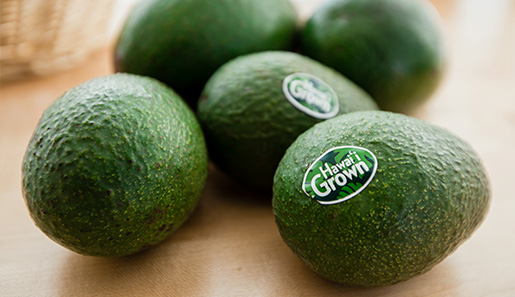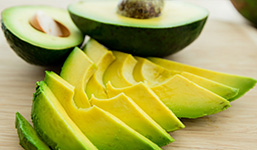 |
|
SPOTLIGHT |
|
|
|
|
|
| So Local and So, So Good |
Hawaii boasts more than 200 varieties of avocados and while they grow throughout the state, they are most prolific in the coffee growing areas of the Big Island where wind conditions, elevation, and rainfall make for ideal conditions. All three main types of avocados— the thin, smooth skinned Mexican, the thick, hard, brittle skinned Guatemalan, and the shiny, medium skinned West Indian— are grown here plus lots of hybrids. The Sharwil — a Mexican-Guatemalan cross with green skin, small seeds and yellow-green flesh that many say is the best of the best — is the most commonly grown variety in the islands.
Avocados are believed to have come to Hawaii from ships that traveled to the islands from Mexico, Central and South America, Spain, Portugal, Brazil, and Puerto Rico. Traders ate the avocados in transit and saved the seeds of those they liked. The seeds were planted in the islands and the best varieties were cultivated and grafted to give us the many types we have in the islands today.
Avocado aficionados will likely tell you that there is nothing quite like a local, Hawaii-grown avocado. They are ultra-buttery, never bland, and always full of flavor! And we are proud to be working with local farmers to ensure local avocados are available for you at Foodland nearly all year long.

Here are some interesting facts you may not know about this very special fruit:
|
Ready or Not? Avocados don’t ripen until they’ve been picked, but knowing when they’re ready to eat is no easy task! The shiny skins of most avocados turn dull when they’re ripe and Hass avocados tend to darken from bright green to almost black as they ripen. Squeeze-testing — to see if the avocado gives slightly to firm, gentle pressure — is always a good way to go, but here’s another trick you might not know: Peel back the small stem or cap of the avocado. If it won’t budge, it’s not ripe. If it pops off easily to reveal bright green, you’re good to go. If you find black under there, the avocado is probably overripe.
In a Hurry? Place your avocados in a brown bag and store them at room temperature to help them ripen. Adding an apple or banana to the bag will speed up the process.
Better than Butter! The healthy fats and creamy texture of avocados make them a great substitute for butter in the right ratios when baking. Plus, an avocado has more potassium than a banana, is fiber-rich, cholesterol-free, packed with protein, and full of vitamins, minerals, and phytonutrients.
You Don’t Even Have to Eat Them! You can enjoy the benefits of the antioxidants, amino acids and essential oils of avocados by using them to repair damaged hair, moisturize skin or relieve sunburn!
|
|
|
|
| Did You Know? |
 |
 |
|
|
| Avocados are the Aztec symbol of love and fertility. They don’t self pollinate and need another tree close by to bear fruit. Plus, they grow in pairs on trees! |
|
|
|
|
 |
|
RECIPES |
|
|
|
|
|
| Local Avocado Toast |
| Serves 2 |
|
|
|
| What better match than crunchy toast and creamy avocado? This dish is quick and easy to make, and great to eat at any time of the day. For a heartier meal, add bacon and sliced tomatoes, or try it with spicy ahi poke on top! |
| INGREDIENTS |
- 1 small local avocado
- 2 slices whole grain bread, toasted
- Fresh pea sprouts
- Sea salt to taste
- Fresh-cracked black pepper to taste
- Extra-virgin olive oil
|
| INSTRUCTIONS |
- Cut avocado in half. Remove pit, then scoop avocado flesh into a bowl.
- Season with a pinch of sea salt and fresh cracked pepper. Mash with fork until chunky.
- Divide between two slices of toast and spread evenly.
- Garnish with pea sprouts, fresh-cracked pepper and sea salt. Drizzle with extra-virgin olive oil.
|
|
 |
| Did you make this recipe? |
| Let us know how it turned out for you! Share a picture on Instagram with the hashtag #FoodlandEatLocal |
|
| How can you tell it’s local? |
| Look for the ORANGE SIGNS |
| to find locally grown and locally made items throughout our stores. |
|
|
|
|
|
|
|

